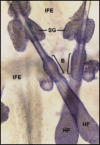Differentiation of the sebaceous gland
- PMID: 20224685
- PMCID: PMC2835892
- DOI: 10.4161/derm.1.2.8486
Differentiation of the sebaceous gland
Abstract
The sebaceous gland is renewed throughout adult life and homeostasis of this particular organ is controlled by a precise interplay of hormones, cytokines, signalling molecules and mediators of the lipid metabolism. Although the true function of sebaceous glands has yet to be fully determined, recent evidence demonstrates that normal homeostasis of the sebaceous gland and functional lipid metabolism of sebocytes is crucial for maintenance of the skin barrier. In addition, analysis of mutant mouse models revealed a close interdependency of the sebaceous gland with hair follicles because abnormal morphogenesis of sebaceous glands often results in degeneration of hair follicle structures. Anomalous regulation of sebaceous glands is involved in the pathogenesis of acne, one of the most prevalent human diseases, or could lead to formation of sebaceous hyperplasia and tumours. This review highlights some of the recent findings on the importance of signalling pathways controlling morphogenesis and differentiation of the sebaceous gland in vivo.
Keywords: SCD1; c-myc; differentiation; epidermis; hedgehog; sebaceous gland; sebocyte; skin; β-catenin.
Figures


References
-
- Millar SE. Molecular mechanisms regulating hair follicle development. J Invest Dermatol. 2002;118:216–225. - PubMed
-
- Niemann C, Watt FM. Designer skin: Lineage commitment in postnatal skin. Trends in Cell Biology. 2002;12:185–192. - PubMed
-
- Schmidt-Ullrich R, Paus R. Molecular principles of hair follicle induction and morphogenesis. Bioessays. 2005;27:247–261. - PubMed
-
- Thiboutot D. Regulation of human sebaceous glands. J Invest Dermatol. 2004;123:1–12. - PubMed
LinkOut - more resources
Full Text Sources
Other Literature Sources
